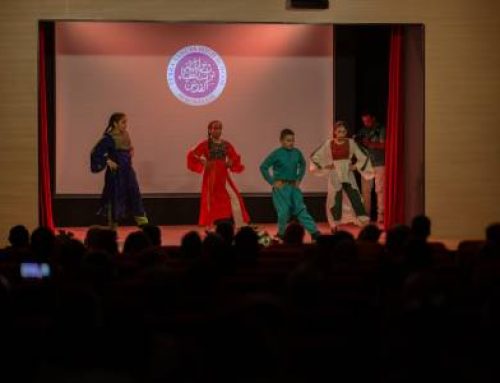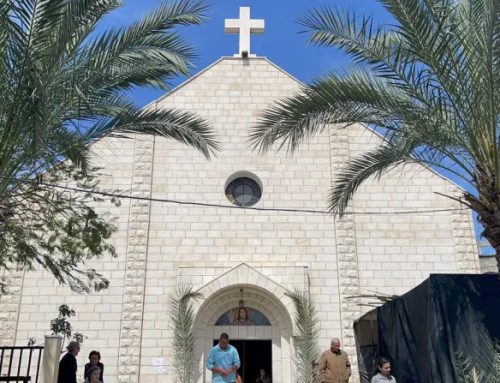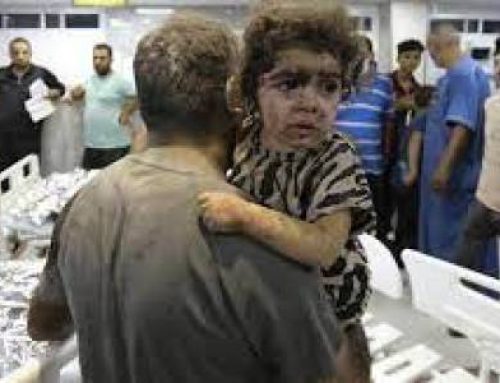Heavenly Father, in this place, which saw the conversion of the Apostle Paul, we pray for all who believe in the Gospel of Jesus Christ. Guide their steps in truth and love.
Heavenly Father, in this place, which saw the conversion of the Apostle Paul, we pray for all who believe in the Gospel of Jesus Christ. Guide their steps in truth and love. May they be one as you are one, with the Son and the Holy Spirit. May they bear witness to the peace, which surpasses all understanding, and to the light which triumphs over the darkness of hostility, sin and death.
HH Pope John-Paul II at Quneitra, Syria
Pilgrim’s Progress …
His Holiness Pope John-Paul II concluded this week his ninety-third trip to Greece, Syria and Malta. This 81-year old Pilgrim Pope, as he has come to be known the world over, managed to defy his failing health as well as the political odds of this challenging trip in order to tread in the footsteps of St Paul. In Syria, the apostle Paul had been converted to the Christian faith in a moment of blinding revelation on the road to Damascus. In Greece, he had introduced Christianity to the Athenians on top of the Areopagus Hill – next to the Acropolis. This was the scene for one of his most stirring speeches in AD 51 as recorded in the Acts of the Apostles. In Malta, he had been shipwrecked in AD 60 before being shunted back to Rome for execution. The Italian daily newspaper La Stampa wrote in its editorial last week that this journey was more of a Calvary than a pilgrimage for the 262nd Bishop of Rome, and compared his ordeal to the sufferings of Christ.
But how can one briefly assess the merits and demerits of this latest pilgrimage? What were the pitfalls in the stations that marked the latest journey of his pontificate to date? And where does Christianity stand now?
In Greece …
It had been quite obvious for some time now that the first station in Greece was going to most difficult from an intra-Christian perspective. In a country where Greek Catholics number no more than 200,000 or 5% of the overall population, the Greek Orthodox hierarchy had vociferously opposed this visit. In fact, so strong was its resistance that it evoked an atypical outburst from the Eastern Orthodox Ecumenical Patriarch in Constantinople, who lambasted those clerics displaying unseemly provincialism in opposing the papal pilgrimage. Critical voices were similarly heard from HE Theoklitos, Metropolitan of Salonika, and the renowned theologian Aristidis Panotis who criticised the Orthodox tendency to demonise Catholicism.
Religious Tensions …
But why were there so many tensions? Why was there so much resistance by Metropolitan Christodoulos, Greek Orthodox Primate of Greece, to this visit? Why did a sizeable number of the Greek Orthodox clergy oppose this first pilgrimage to the cradle of Hellenism being undertaken by the successor to St Peter?
The soreness between the ‘two lungs’ of the Christian Church – western and eastern, Latin and Byzantine, catholic and orthodox – traces its inveterate roots back to almost one thousand years. This is the date of the Great Schism of 1054 when eastern and western Christianity split, and when the predecessors of the two churches maligned each other’s segments of Christendom.
However, a more immediate quarrel is only 800 years old and concerns one of the most ill-starred episodes of Christian history. It relates to the sacking of Constantinople by the rapacious Venetians during the Fourth Crusade in 1204. This Crusade began, like the earlier three, with a call from Pope Innocent III. He drummed up support from French nobles and made a fateful contact with the Venetians to provide transport. The crusader army that arrived in Venice in 1202 was far smaller than anticipated and could not pay for its ships. The Venetians agreed to provide transport so long as the crusaders helped them to fight the Hungarians – despite a veto by Pope Innocent III – and to divert later to Constantinople in order to gain the throne for Alexius, whose brother-in-law Philip of Swabia was a leading crusader.
Constantinople fell in 1203 and Alexius was installed as Byzantine emperor. The Greeks promptly assassinated him. The Venetians and the crusaders, making no effort to continue to the Holy Land, took over the government. On 13 April 1204, the rank and file went on a three-day orgy of massacre and pillage. Thousands were killed. The Pope was aghast. His dreams of reuniting the eastern and western churches were shattered. However, the crusaders showed no interest in leaving and put their own monarch, Baldwin of Flanders, on the throne and appointed a Venetian patriarch. This puppet Latin state lasted only until 1261, but laid nonetheless the seeds of lasting antagonism. The resentment has burnt for centuries, and is best captured in a famous painting by Eugene Delacroix, which depicts this episode in all its visual starkness.
In fact, the Greek Orthodox hierarchy does not only blame the Catholic Church for those tragic events. It still recalls the ‘Councils of Union’ of Lyons in 1274 and of Ferrare and Florence in 1438 when any military assistance by the West to a Constantinople besieged by Muslim forces was made conditional upon a submission of orthodoxy to the Roman pope. Indeed, all attempts to ‘re-conquer’ orthodoxy by orders such as the Jesuits, as well as by the Catholic monarchs of the time – Austro-Hungarian, Polish, Lithuanian – have left their indelible traces on the historical sub-conscious of the Orthodox Church. In fact, some segments of the Greek Orthodox Church also blame the West for not moving against the Turkish invasion of Cyprus in 1974.
However, if those issues are deemed today as being ‘historical’ or ‘pseudo-historical’, other more contemporary – and ostensibly more irascible – concerns play on the psyche of the Greek Orthodox Church today.
Ever since the collapse of communism in the former USSR and Eastern Europe, the Catholic churches have re-constituted themselves in many of those countries. They have re-appropriated many of their properties and have begun to witness actively to their faith in those countries. The presence of those ‘uniate’ churches – which observe the orthodox rites but remain faithful to Rome – in Orthodox countries such as Russia, the Ukraine, Georgia, Greece and many others has opened up the Catholic church to accusations of proselytism. The fact that the Pope has often supported those churches has equally exacerbated the suspicions of the Orthodox hierarchy – chief amongst them HB Patriarch Alexis II – that this ‘uniatism’ aspires to convert the Orthodox faithful into Catholicism. Add to those issues the question of papal infallibility – which is strictly defined these days anyway – and perhaps even the ‘primacy’ of the Bishop of Rome, and one can begin to detect additional contributory factors of dissection between those two supposedly sister churches.
A Forecast …
It remains my belief that those tensions between the Orthodox and Catholic churches have only been softened after the papal visit to Greece. It is true that the pontiff voiced an act of contrition for all torts caused by the Catholic hierarchy over the centuries. It is also true that both sides signed a common – but stilted – declaration condemning, inter alia, violence, proselytism and fanaticism in the name of religion. The Pope might even have engendered a somewhat tepid re-appraisal in the attitude of the Greek Orthodox hierarchy. Yet, I believe that a gulf still exists – and remains yawningly wide. There were no public common prayers! There was no traditional agape meal, a breaking of bread together, perhaps to avoid a common prayer! True, those are symbols but symbols are potent indicators too. The attitude of the Greek Orthodox Church in Greece was unfortunate at best and boorish at worst. It is true that there are many sources of tension and friction between the two Churches. But surely, such an anti-ecumenical posturing in the new millennium will have been an embarrassment to the Body of Christ? My forecast remains dispiriting, and the future alone will tell whether the seeds of a more convivial future between those two lungs of the Church were indeed planted this week.
In Syria …
And then, the Pope flew from Spata airport just outside Athens to Syria and yet another first!
Unlike Greece, the primary directive here was as much the enhancement of intra-Christian relations as it was the call for a constructive dialogue between Christians and Muslims in the Middle East. The Pope shares the belief of many local Christian leaders for the crucial need to maintain the Christian communities in the Middle Eastern region since their presence guarantees the universal values of independence, pluralism, confessional equilibrium and respect for the dignity of all humankind.
In this respect, his visit to the Umayyad mosque in Damascus was a notable achievement for inter-faith relations. This mosque was a church until the Arab conquest in the 7th century. It contains the tomb of St John the Baptist who is also revered by Muslims as the prophet Yahya. Here, symbols of reciprocal acknowledgement were most visible again. The image of the Grand Mufti and many ulemas (Muslim teachers) welcoming a roman pontiff across the threshold into their holiest sanctuary was a telling achievement.
However, the papal visit to Syria – a country where Christians form 14% of the 17-million population and where Aramaic is still spoken in three villages – was also festooned with ecumenical dimensions. The Pope concelebrated Holy Mass at the Abassiyin stadium in Damascus and concluded it with the Regina Coeli. He visited the Greek Orthodox Cathedral of the Dormition of the Virgin Mary, the Greek Catholic Patriarchate – whose newly-elected Patriarch Gregorius III Lahham was the organiser of the pilgrimage to Syria – as well as the Syrian Orthodox Patriarchate for ecumenical encounters. He went to the Church of St Paul at the Kissan gate in the old walls of Damascus, whence the apostle Paul had escaped by being lowered in a basket. He also had an encounter with the youth of Syria – one of the popular highlights of the pontificate of Pope John-Paul II.
A major cornerstone of his pilgrimage to Syria was a visit to the ruined village of Quneitra in the Golan Heights. This political gesture, which coincided with a visit to St George’s Greek Orthodox Church, was a reminder to the whole world that the political realities of this region remain as volatile as they are unresolved. From there, the Pope launched a strong prayerful plea for peace in the Holy Land and in the world.
Political Tensions …
Nonetheless, politics inevitably crept into the pilgrimage in Syria. Indeed, the welcoming speech by President Bashar Assad was a none-too-subtle attack on the Jews. In his speech, the President asserted that the Jews had betrayed Jesus and tried to kill the prophet Mohammed. His inopportune choice of words in front of a pilgrim of peace and a messenger of mutual tolerance between the three monotheistic traditions led to much discomfiture within some Vatican and Catholic circles. It also contradicted the official line of the Vatican that had rejected the charge of deicide against Jews at its Council of 1963. Whilst it was understandable that the President, as much as some Christian and Muslim religious leaders, wished to use the papal visit to bolster their legitimate political grievances, such words dwarfed the Pope’s message of reconciliation.
There were voices raised that the Pope had remained silent and unresponsive as much to such political declarations as to the Syrian military presence in Lebanon. But I believe that he maintained his time-honoured custom of adhering to his own script and not deviating from his original thoughts. Having said that, the Pope did affirm those principles of international legality that proscribed the acquisition of territory by force, the rights of all peoples for self-determination and compliance with the UN resolutions and Geneva Conventions.
A Forecast & Future Plans …
I believe the papal pilgrimage to Syria affirmed the Christian indigenous presence and witness against a haemorrhaging tide of emigration, as much as it enhanced Christian-Muslim relations, in the whole region.
The Pope then flew to Valetta, Malta, for the second time in eleven years where the overwhelmingly Catholic population gave him a rapturous welcome. He now plans to visit the Ukraine in June 2001, and then Armenia in September 2001 to participate in the celebrations marking the 1700th anniversary of Armenia adopting Christianity as a nation-state. It seems that this Pilgrim Pope has little intention of slowing down the pace ..!
Merciful Father, may all believers find courage to forgive one another, so that the wounds of the past may be healed, and not be a pretext for further suffering in the present. May this happen above all in the Holy Land, this land which you have blessed with so many signs of your Providence, and where you have revealed yourself as the God of Love.
HH Pope John-Paul II at Quneitra, Syria
(c) harry-bvH @ 11 May 2001





